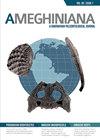阿根廷萨尔塔省Subandean Range早至中泥盆世Pescado组孢粉学
IF 1.5
4区 地球科学
Q3 PALEONTOLOGY
引用次数: 1
摘要
摘要我们介绍了从阿根廷萨尔塔省Subandean山脉Pescado组中恢复的孢粉植物。孢粉组合包括保存完好的海洋和陆地孢粉形态,包括隐孢子(1种)、三孢子(16种)、针状孢(6种)、裸孢(3种)和绿藻(3种)。通过对孢粉组的定量分析和地层分布,确定了两个孢粉组(RC1、RC2)。此外,RC1和RC2还存在Dictyotriletes emsiensis morphon和Acinosporites apiculatus,以及Duvernaysphaera angelae和D. tenuicingulata,表明RC1和RC2的存在时间较晚。所研究的组合包含许多与冈瓦纳其他同时期组合相同的分类群,证实了阿根廷Precordillera, Tarija盆地和乌拉圭南部chacoparan本文章由计算机程序翻译,如有差异,请以英文原文为准。
Palynology of the Early to Middle Devonian Pescado Formation, Subandean Range, Salta Province, Argentina
Abstract. We present the palynoflora recovered from the Pescado Formation in the Subandean Range, Salta Province, Argentina. The palynological assemblage comprises well-preserved marine and terrestrial palynomorphs, including cryptospores (one species), trilete spores (16 species), acritarchs (six species), prasinophytes (three species), and chlorophytes (three species). Based on the quantitative analysis and stratigraphic distribution of palynomorphs, two palynological associations are recognized (RC1, RC2). The presence of Dictyotriletes emsiensis morphon and Acinosporites apiculatus, together with Duvernaysphaera angelae and D. tenuicingulata, suggests a late Emsian–Eifelian age for RC1 and RC2. The studied assemblages contain many taxa in common with other coeval assemblages of Gondwana that confirm the paleogeographical relationships among the Argentine Precordillera, the Tarija Basin, and the southern Chacoparaná Basin in Uruguay. The relative abundance of the palynomorphs encountered suggests a marine depositional environment close to the paleo-shoreline for the RC1, and a more distal marine setting for the RC2, possibly nearshore, reflecting the Eifelian transgression. This event, already documented by different authors, is also recognized in the southern portion of the Tarija Basin.
求助全文
通过发布文献求助,成功后即可免费获取论文全文。
去求助
来源期刊

Ameghiniana
地学-古生物学
CiteScore
2.50
自引率
10.00%
发文量
21
期刊介绍:
Ameghiniana is a bimonthly journal that publishes original contributions on all disciplines related to paleontology, with a special focus on the paleontology of Gondwana and the biotic history of the southern hemisphere. Published yearly since 1957, it has undoubtedly become the main palaeontological publication from Latin America. Ameghiniana has recently broadened its editorial board, reorganized its production process, and increased to a bimonthly frequency, which resulted in a significant decrease in the turn around time.
 求助内容:
求助内容: 应助结果提醒方式:
应助结果提醒方式:


